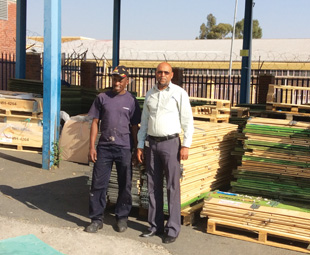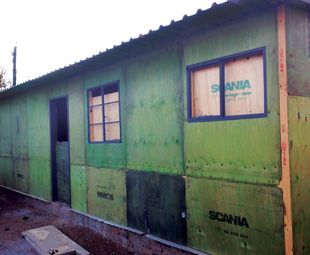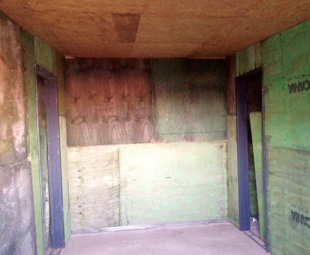The house that scania built!

Regular FOCUS readers will know that I am spending a lot of time with the Scania team, because these wonderfully patient people are helping me to get my truck driver’s licence. What I didn’t expect (but did get) was a lesson in recycling and sustainability …
Passion oozes out of his pores. That’s probably the best way to describe Scania’s Shein September. He used to be responsible for driver training within the company; now he’s in charge of service sales.
September is, however, not one to limit his activities to his formal areas of responsibility; he gets involved in all sorts of stuff. Mention road safety, for instance, and you won’t get him to shut up for hours. That’s because he is truly passionate about road safety. As such, he’s involved in lots of road safety initiatives …
Well, it turns out that September is also passionate about the environment. This passion led him to wonder all about the waste from packaging material that is generated at Scania.
Components, cabs and kits all arrive from Sweden in robust crates, which are discarded once they have been emptied. “They can, of course, go for recycling … but I thought that, possibly, these crates could be better utilised,” September tells FOCUS.
Being a rather ingenious fellow, he wondered if it wasn’t perhaps possible to use this packaging material to alleviate one of this country’s greatest challenges: a dire shortage of housing.
September is neither a trained builder nor a professional architect, but this didn’t deter him. “I drew a plan in my notebook, then I bought a 100-litre compressor, a nail gun, a circular saw, hammers … all the tools I needed. I hired one of my colleagues, Nepo Seboko, to work with me over weekends – because he’s a qualified builder. And we set out to build a house!” he explains with a big grin.
That was four months ago. (September had to check his golf diary to work out how long he’s been in the house-building business – and it’s been four months since he played a round.)
Now he’s built his first house! Understandably, he’s just like a proud parent. “The bulk of the house was built using the lids of the crates. The wood is really good! It’s obviously been treated; the crates live at sea for six to eight weeks. The lids are good because they’re bigger than the sides of the crates. It takes about 120 lids to build one house,” he reveals.
 The ceiling is made out of corkboards that were also derived from Scania packaging material. Insulation is also achieved using these corkboards, which are packed between the panels. A thermal sheet is also fitted between the panels to provide heating and cooling.
The ceiling is made out of corkboards that were also derived from Scania packaging material. Insulation is also achieved using these corkboards, which are packed between the panels. A thermal sheet is also fitted between the panels to provide heating and cooling.
The only substantial part of the house that doesn’t emanate from the Scania scrapyard is the foundation. “You obviously need to invest in a proper foundation; that’s essential. I also bought some aluminium sheeting, which I shot into the ground, so that the wood would not get wet,” September explains.
September is not an electrician or a plumber, so, while he and Seboko have done the bulk of the labour, he has enlisted the services of professional tradesmen for the finishing touches.
“So the entire building is completely legal, with all the required certification. We have also taken the necessary precautions to ensure that it’s not a fire hazard. The wiring is not connected; it is one solid wire. The plugs aren’t mounted in the wood; they’re mounted onto plastic. We are discouraging people from using gas – because it comes with electrical connections. There is even an aluminium sheet above the stove,” he explains.
Naturally, because September is not a builder, the house has evolved over the months. “I’ve never done anything like this before. My experience is in fleet management and Scania vehicles!” he says with a laugh. “So it was a bit of trial and error … but I’m delighted with the end result.
 The final house measures 45 m². It comprises two bedrooms, a lounge, kitchen and bathroom (including a toilet and shower). September is now building shelving and cupboards for inside the house – using old pallets that he has scrounged from the Scania scrapyard, of course.
The final house measures 45 m². It comprises two bedrooms, a lounge, kitchen and bathroom (including a toilet and shower). September is now building shelving and cupboards for inside the house – using old pallets that he has scrounged from the Scania scrapyard, of course.
This is not September’s first foray in the area of social responsibility. He and his supportive and understanding wife (who has not had a husband for four months) visit a farm each month to buy meat for the poor. Their daughters always share their lunch with the underprivileged.
“It’s just our way of life,” he explains. “I believe in helping people. People don’t choose to be poor, and when you see the shacks in our country … I just thought that there had to be a better way of doing things.”
September believes that this house will last for 20 years, and he wants to build many more. “I estimate that we can build 25 to 30 houses a year using the raw materials that we have at Scania. This is just the beginning!” he notes with real glee.
Who knows? One day you may drive past an entire village that has Scania impregnated into the walls of its houses. And you’ll know where it all started …
Published by
Focus on Transport
focusmagsa





 FUSO: Driving the Future of Mobile Healthc
FUSO: Driving the Future of Mobile Healthc



 New Electric Van Range Unveiled!
New Electric Van Range Unveiled!  A brand
A brand




 Wondering about the maximum legal load for a
Wondering about the maximum legal load for a 
 The MAN hTGX powered by a hydrogen combus
The MAN hTGX powered by a hydrogen combus


 Exciting News for South African Operators
Exciting News for South African Operators






